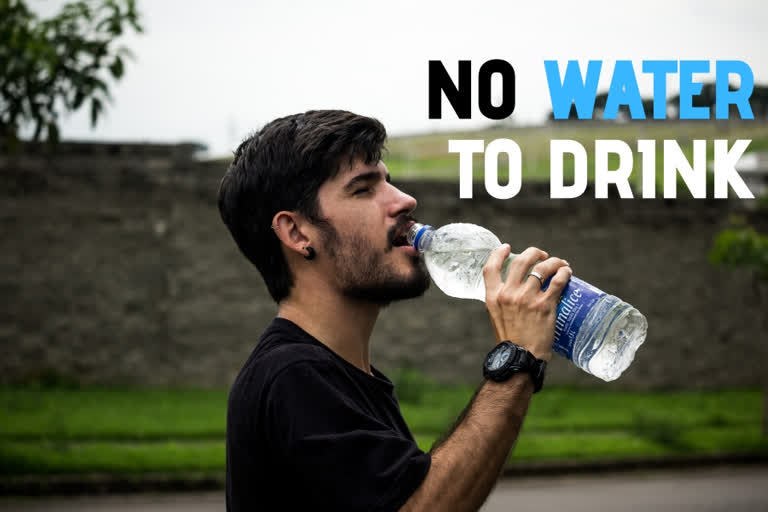Hyderabad: Water shortage and quality of drinking water are the biggest issues concerning the people today in India. Though the country has perennial water bodies like the Ganga, Godavari, Krishna, Kaveri, Yamuna and Narmada, water crisis is still rampant.
It is worrisome that the underground and surface water sources are contaminated with chemicals and plastic waste emanating from the industries. In this background, having no trust on the quality of tap water, people are opting to purchase drinking water, despite which people are still falling sick.
The RO water business
The Reverse Osmosis (RO) water centres have started flooding the market with their bottled water cans. The RO business was set up on the basis of people's water needs and their fright of using direct tap water. However, these centres do not function under hygienic conditions and distribute adulterated or tapped water itself, under the name of bottled water. To this end, the National Green Tribunal (NGT) recently expressed outrage over the illegally established freshwater plants. The Union Ministry of Environment and Forests has ordered the cutting of the salaries of its officials from January if the Reverse Osmosis (RO) plants that are unable to give back at least 60% of the total treated water are not banned by December 31.
It has further ordered that RO water in areas where the concentration of Total Dissolved Salts (TDS) is less than 500 milligrams per litre, should be shut down. The RO Plant Manufacturers Association filed a petition in the Supreme Court seeking a stay on this, and the apex court had recommended that the relevant department at the Centre be consulted for the same.
Read: Water crisis in India: Hard times for cities
However, there are situations where the RO water cannot be completely banned from our daily water needs. People are dependent on RO bottled water, as tap water is found to be contaminated in some areas and in some others, water is affected with hazardous fluoride and metal concentrations, and high-risk elements. For example, in both the districts of East and West Godavari, drinking and cultivating water was contaminated with chemical fertilizers, pesticides and wastage emanating from shrimp farming and saltwater that is used for aqua-cultivation. The water in those areas is now not fit to use unless it is purified with RO technology.
No trust on tap water
Just because water comes in bottles or cans does not guarantee its purity, as the alkalinity, acidity, and concentration of heavy metals are only revealed by thorough inspection. Therefore, there is not much of a difference found by an ordinary buyer between the water treated under the standards set by the Bureau of Indian Standards (BIS) and the water treated with ordinary RO Plant machinery. Both look identical except for taste and quality. This situation is turning out to be advantageous for the RO Plant vendors. Though the central government and state governments are spending billions of rupees on the supply of treated water, it is not proving to be useful for the common man who is ultimately turning towards RO water being supplied by private agencies.
Irrespective of whether it is a town or a village, the tap water supplied by the government is not found qualitative enough for people to consume. Hence, people are turning towards RO water. In the Telugu states, drinking water reservoirs and protected drinking water schemes are adversely affected by mismanagement. The reservoirs and tanks are not cleaned timely, leakages are not taken care of duly, which is causing contamination of water and the same is being supplied by taps. The purification process by the staff of local corporations is confined to just chlorination of the water and the same water is supplied to local homes through pipes.
Prior to the state split in 2009 and post-2014, there were no indications of the distributed water test kits being utilised in the two states. In many cities and towns, pipelines dug up 30-40 years ago have become corrosive and perforated. With the sewage and drainage system lying next to these pipelines, it causes both the lines to get mixed up and thereby contaminating the drinking water. Governments do not care about the quality and management of the underground pipelines which are to be replaced every two to three decades, as it is a costly affair. As a result, citizens are reluctant to use such drinking water supplied by the government and prefer drinking water cans over tap water, despite the cost of the water cans.
In Germany, Russia and the US, there is no prohibition on RO water, but there is no encouragement of using the same as well. However, in India, RO plants are spreading like mushrooms due to lack of supervision. There is no control on the water plants in the Telugu states. It is estimated that there are more than 18,000 RO plants in the two states, with 90 per cent of them being unauthorized.
In order to set up an RO Plant in accordance with the BIS rules an investment of at least Rs 25 to 30 lakh is required. If it is set up, a 20-litre container can cost up to Rs 30 per can. Since people do not prefer to spend this sort of money, the RO plant vendors are coming up with a minimum investment of Rs 4-5 lakh and setting up the plants with low-quality machinery and thus are providing only nominally processed and lowly treated water to the people. Such water doesn't consist of any minerals and is also cheaply priced. People purchase these cans in the misconception of qualitative water at a cheaper price.
